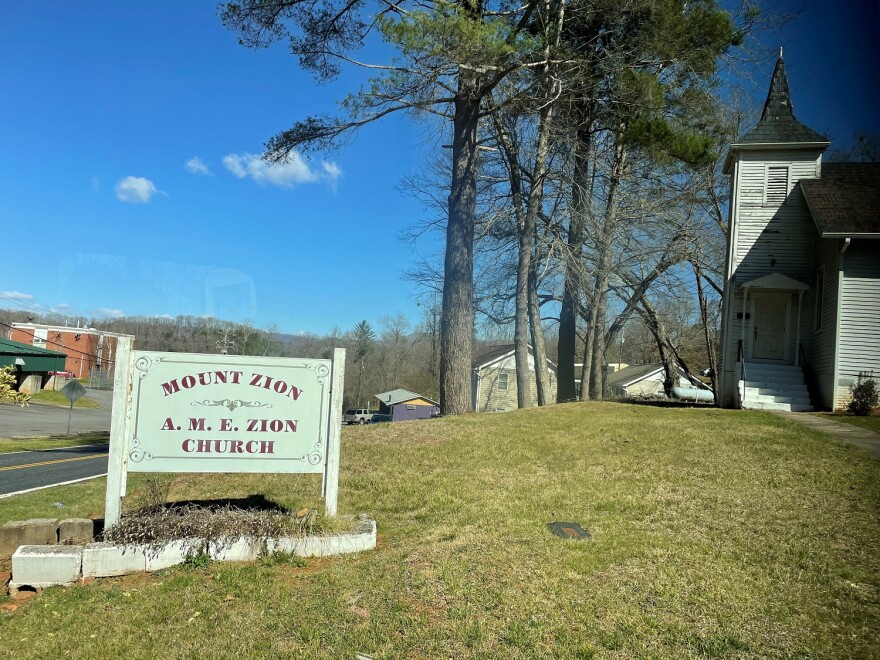The Jackson County NAACP hit the road recently to highlight Black history in the region. BPR went along for the tour.
The five-site tour exploring Black history across Western North Carolina started with a stop at Liberty Baptist Church in Sylva.
“That’s my grandmother right there. She was the church clerk forever and ever.”
Marjori Herbert points to a photograph in the church basement. Her father Joseph H. Smith was pastor at the church for over 50 years. She explained that the church was founded by 10 formerly enslaved Black people in 1871.
“First it was in a log cabin and then I think they moved to two or three different places before they finally purchased the plot here and built here,” said Herbert.
Three other historic Black churches: Mt. Zion AME Zion of Cullowhee, St. Cyprian’s Episcopal Church – now All Saints Episcopal Church in Franklin, and Pleasant Hill AME Church in Cowee were also part of the tour across Jackson, Macon and Swain Counties.

Local historian Ann Miller Woodford lead the bus tour. Woodford grew up in segregated Cherokee County and has written a book about the Black history of Far Western North Carolina.
Just up the hill from Liberty Baptist Church, sits the Jackson County School Board Central office. The building was the segregated school from 1956 until 1965 when schools were desegregated in the county .
Woodford explains that before the school was built there were six Rosenwald schools across the far western region. Rosenwald schools were built with matching funding from philanthropist Julian Rosenwald to provide quality education for Black children in the South.
In Jackson County, Woodford says the Black community were able to raise a significant amount of matching to build the school. They raised about $2,100 dollars – which would be about $34,000 today according to Woodford.
“I feel really proud of the people who were back there. I walk in their path now. Without them I would not be able to write or read or be here talking with you now,” said Woodford.
She hopes others will be inspired in the same way she is to learn more about the history of the everyone in the region.
“ I say, ‘You didn’t do this. You didn’t do these personal things to the African American people. You didn’t make slaves. But everyday that you don’t pay any attention because you are in an area that is 96-97 percent white you don’t have to care. So it’s important for me to point out that you need to care. You need to take an extra step to learn what it’s like to be in the shoes of a Latinx person, a Native American person or an African American person,” said Woodford.
One of the next stops was the West Mill area in Macon County. The area had the largest rural Black community west of the Balsam Mountains in the 1900 census. Just up the road at the Cowee School, the tour explored the rooms of crafts people from quilters to locals learning pottery.
“This school is the center of a 360-acre historic district which is one of the largest ones in the state,” said Stacy Guffey, director of The Cowee School. He’s also a member of the Franklin Town Council. The school was built in 1943 by a Civilian Conservation Camp.
The last stop of the day was at the Mingus Mill in the Great Smoky Mountains National Park near Cherokee in Swain County. Atalaya Dorfield is with the park’s African American Experience Project. Launched in 2018, the project collects oral histories and artifacts about Black people who lived in and around the Smokies.
“The Smokies realized that we weren’t looking enough into the Black history of the area. We know a lot of white settler history and Cherokee history but we didn’t have that many Black and African American stories,” said Dorfield. She explained that Black people have been in this area since the 1540s.

Part of that history includes at least six cemeteries of enslaved people in the park.
One of them is near the Mingus Mill. People enslaved by the local Mingus and Enloe families are buried there, explains Dorfield. People place coins on the gravestones
“What people do is they come up here to pay their respects to the people who passed away here,” said Dorfield.
In July 2020, Western Carolina University professors conducted ground penetrating radar research to map the grave site. They potentially found additional graves. Eight graves have been found so far.
“GPR looks a little bit like a lawn mower. What Blair [Tormey] does is he will go over where we know that there are burials and it just tells us what is beneath the earth. We believe that they were buried in wooden coffins,” said Dorfield.
Dorfield also shared that the grandfather of famous jazz musician Charles Mingus was enslaved by the Mingus family.
At the end of the day, the tour bus returned to Sylva. Attendees reflected on what they learned including Chancellor Kelli Brown of Western Carolina University. She says it’s crucial to learn about the people and history that make up the core of the region.
“It’s overwhelming when you think about everything that we did talk about today and what we learned. It’s part of who we are and the fabric of not only Western North Carolina but the fabric of the United States. And when you get to experience it with the people who have direct experience with it. It really makes it real,” said Brown.
The tour is open to the public to take anytime through a free mobile app created by the Jackson County NAACP Branch and the Western Carolina University Mountain Heritage Center. The project is part of "Journey to Freedom, Together” project which brought local artist Wesley Wofford's sculpture of Harriet Tubman to Sylva in the fall.



